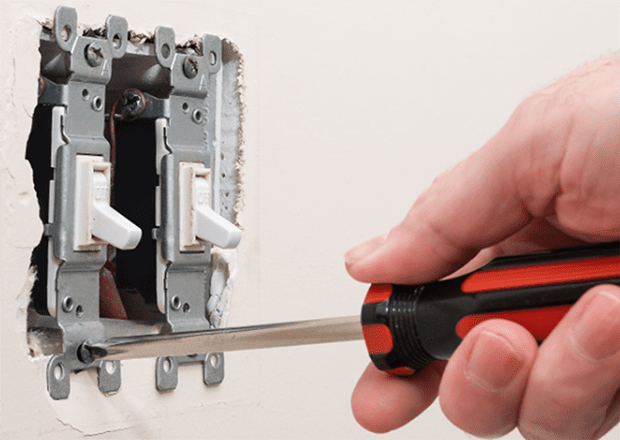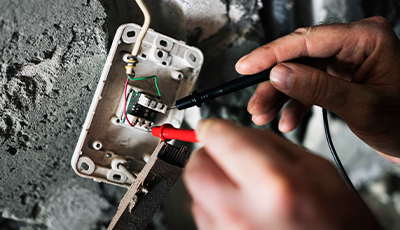Usual Electric Issues Every Property Owner Must Find out about
Property owners typically encounter numerous electrical problems that can impact safety and capability. Problems like flickering lights and tripped breaker are much more typical than many recognize. These scenarios can indicate deeper electric problems that warrant interest. Comprehending the indications and threats connected with obsolete wiring and dead outlets is essential. What measures can be required to protect against these problems? Exploring these usual electric concerns could disclose essential insights for preserving a safe home environment.

Flickering Lights: Causes and Solutions
Why do some homeowners experience flickering lights? Flickering lights can be a typical annoyance, typically showing underlying electric concerns. One main cause is loose or faulty links within lights or electrical wiring, which can bring about intermittent power supply. Additionally, making use of high-wattage devices on the same circuit may trigger voltage variations, causing flickering or dimming. Another prospective issue is an overloaded circuit, where way too many tools attract power concurrently, stressing the electric system. Furthermore, obsolete or abject wiring can contribute to irregular electrical flow. In many cases, flickering lights might signal a trouble with the home's electrical panel or solution line. Home owners must address flickering lights immediately to avoid potential threats. Solutions might consist of tightening up connections, rearranging home appliance load, or getting in touch with a licensed electrician for a thorough analysis. Recognizing the root cause can aid ensure a risk-free and stable electrical system in the home.
Tripped Circuit Breakers: What You Need to Know
Have homeowners ever before wondered what triggers their breaker to trip unexpectedly? This usual problem usually emerges from an overload of electrical circuits, where too lots of tools draw power simultaneously. In such instances, the circuit breaker acts as a safety and security system, interrupting the circulation of electrical energy to avoid overheating and possible risks. An additional regular reason is a short circuit, which takes place when a real-time cable calls a neutral wire, developing a rise of electrical energy that journeys the breaker. Ground faults can likewise cause tripped breakers; these take place when a real-time cord touches the ground or a grounded surface area, positioning serious security threats. Property owners ought to frequently analyze their usage of high-wattage home appliances to stay clear of overwhelming circuits. In addition, understanding the function of breaker can help them respond suitably throughout a journey, ensuring their home stays properly maintained and safe.
Out-of-date Wiring: Signs and Threats
Obsolete wiring can present substantial threats to house owners, frequently going undetected till troubles arise. Homes built prior to the 1980s may still have aluminum wiring or knob-and-tube systems, which are no much longer taken into consideration secure. Indicators of outdated wiring include flickering lights, often tripped breaker, or melting scents near electrical outlets. These signs may recommend that the electric system is loaded down or deteriorating.Additionally, house owners could see swelter marks around outlets or buttons, which can show getting too hot. The risk of electrical fires noticeably raises with outdated wiring, as these systems were not designed to handle modern electric loads. Homeowners are motivated to have their wiring evaluated regularly, particularly when refurbishing or including new home appliances. By recognizing these indicators early, they can stay clear of unsafe scenarios and preserve a safer living setting. Updating to existing electric standards is a proactive action in preserving home safety and performance.
Frequently Blown Fuses: Repairing Tips
Constant blown merges can show underlying electrical problems that may originate from out-of-date wiring or overloaded circuits. Homeowners experiencing this trouble ought to initially determine the home appliances attached to the affected circuit. It is a good idea to prevent making use of several high-wattage gadgets all at once, as this can result in circuit overload. If the issue lingers, evaluating the fuse box for signs of wear or damages is critical; a defective circuit box may call for replacement.Additionally, looking for loosened connections within the circuit can help avoid future events. Home owners must additionally verify that the merges being utilized are of the appropriate amperage, as making use of an incorrect fuse can aggravate the problem. Getting in touch with a licensed electrical contractor is advised to review the electrical system even more if these troubleshooting suggestions do not deal with the concern. Resolving these problems quickly can help alleviate threats and guarantee the security of the home's electric infrastructure.
Dead Outlets: Common Causes and Solutions
When a house owner comes across a dead electrical outlet, it can commonly give frustration and confusion. Numerous typical reasons might cause this concern. One frequent wrongdoer my response is a stumbled circuit breaker, which can be easily reset. If any breakers are in the off placement, home owners must examine their electrical panel to inspect. Another possibility is a defective outlet itself, go to this website which might require substitute. Furthermore, loosened wiring links within the electrical outlet can interfere with power circulation, making assessment essential.Sometimes, the problem may stem from an overloaded circuit, specifically when several devices are attached. In such cases, redistributing the electric load can settle the problem. Home owners must also take into consideration the age of their wiring; older systems might require updates to fulfill modern electric demands. If these actions do not correct the scenario, getting in touch with a licensed electrician is suggested to ensure safety and appropriate diagnosis.
Electric Shocks: When to Be Worried
Just how can homeowners figure out whether an electrical shock warrants problem? Property owners should initially assess the extent and context of the shock. A mild static shock, usually felt when touching metal items, is normally harmless and typical. If the shock happens while communicating with a plugged-in device or outlet, it may suggest an extra significant issue.The location and regularity of the shocks are crucial. Repetitive shocks from the same resource, especially in wet locations like kitchens or restrooms, can signal malfunctioning wiring or insufficient grounding. Property owners ought to also think about the experience of the shock; a shock that triggers pain or muscle mass contractions is extra alarming than a simple tingle.If there's any unpredictability, it is a good idea to consult a qualified electrician. Neglecting possible electrical risks can cause major security dangers, including fire or severe injury.
Overloaded Circuits: Avoidance and Precaution
Overloaded circuits posture considerable risks in domestic settings, usually bring about electric fires or devices damages (Level 2 Electrician). Home owners have to acknowledge the indicators of an overloaded circuit, such as regularly tripped breakers or lowering lights. Executing preventive safety techniques can aid alleviate these risks and ensure a more secure living atmosphere
Identifying Overloaded Circuits
What indications indicate that a circuit may be overwhelmed? Property owners need to be try this out attentive for numerous crucial indicators. Often stumbled breaker or blown merges suggest extreme load on the circuit. Dimming or flickering lights, particularly when other home appliances remain in usage, can signify an inadequate power supply. Furthermore, electrical outlets or switches that feel warm to the touch might show overheating, a potential fire risk. Uncommon humming sounds from outlets likewise warrant attention, as they can represent electric concerns. If home appliances run inefficiently or fall short to start, it may be an indication of an overloaded circuit. Identifying these signs early can aid prevent major electric troubles and advertise a much safer home setting.
Preventive Safety And Security Practices
To preserve a risk-free and effective electrical system, house owners must execute preventive security practices that deal with potential circuit overloads. One reliable procedure is to prevent linking too numerous tools to a solitary electrical outlet, as this can surpass the circuit's capability. Using power strips with built-in circuit breakers can help distribute power securely. House owners need to likewise regularly evaluate cords and home appliances for damage and change any type of malfunctioning tools without delay. It is vital to guarantee that circuit breakers are working properly and to be aware of the overall electrical power being utilized in each circuit. Furthermore, seeking advice from a licensed electrical expert for regular evaluations can identify possible problems before they rise, ensuring a safer living atmosphere and prolonging the life expectancy of electric systems.
Frequently Asked Questions
Just how Commonly Should I Have My Electrical System Inspected?
Normal assessments of electrical systems are advised every three to 5 years. Property owners must consider much more constant checks if they experience issues, undertake restorations, or reside in older residential or commercial properties to guarantee safety and compliance.
Can I Deal With Electrical Issues Myself or Hire a Specialist?

What Are the Indications of an Electric Fire Threat?
Indicators of an electrical fire risk include regularly stumbled breaker, flickering lights, melting odors, blemished outlets, or warm, buzzing cords. House owners should stay alert and look for professional help if any of these indications are existing.
Just how Do I Know if My Home Needs an Electrical Upgrade?
To figure out if a home requires an electric upgrade, signs include frequent circuit breaker journeys, obsolete wiring, not enough electrical outlets, flickering lights, and the visibility of older electric panels, showing potential safety and security hazards and inadequacy.
Are There Details Safety And Security Tips for DIY Electric Work?
When taking into consideration DIY electrical job, one must constantly switch off power, use shielded devices, verify circuit functionality, adhere to regional codes, and get in touch with experts for complicated tasks to guarantee safety and security and prevent crashes. Another prospective concern is an overloaded circuit, where also several gadgets draw power all at once, straining the electrical system. The risk of electric fires significantly enhances with out-of-date electrical wiring, as these systems were not created to handle contemporary electric loads. Constant blown fuses can show underlying electrical issues that might stem from out-of-date circuitry or overloaded circuits. To preserve a effective and safe electric system, homeowners have to execute preventive security techniques that deal with possible circuit overloads. Sydney Level 2 Electrician. Indicators of an electric fire threat include often tripped circuit breakers, flickering lights, melting smells, stained electrical outlets, or cozy, buzzing wires
Comments on “Powerless sockets in your home? An experienced Sydney Level 2 Electrician explains the causes”